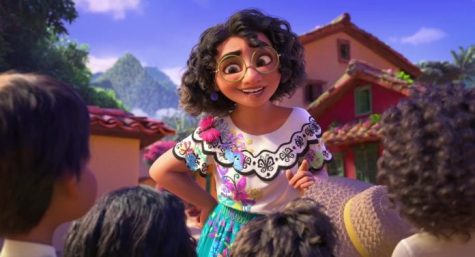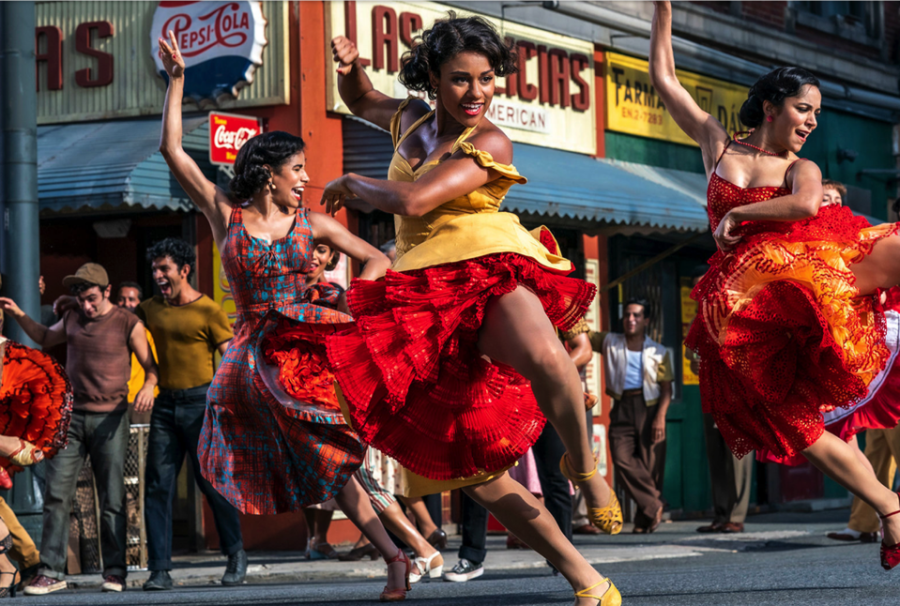Latinx representation in media: Moving towards inclusivity in film
Ariana DeBose as Anita in “West Side Story,” released in 2021. Photo by film set photographer Niko Tavernise.
October 13, 2022
In recent years, Latinx media has seen an increase in popularity, specifically beyond the Latinx community. For the first time, things that were once traditionally Latinx are becoming “mainstream,” raising questions of cultural appreciation versus appropriation in media. This two-part series will explore the current effects of Latinx culture becoming mainstream in music and film in the context of the U.S.
Similarly to the increased popularization of Latinx music (as discussed in part one), there has been a rise in Latinx based films in the United States’ film industry. Being notoriously underrepresented in film, this new wave of Latinx representation has been an exciting breakthrough. Still, these films struggle to fully represent Latinx people.
One area where Latinx representation continuously falls short is through colorism. Colorism is the discrimination of people with darker-toned skin, often within one ethnicity or race. Identification terms such as Latinx or Hispanic are broad labels representing multiple cultures and races, therefore when viewing films that advertise Latinx representation, people expect to see this diversity. Unfortunately, more often than not, the representation tends to lean towards light skinned Latinx actors. This colorism goes beyond just the context of the U.S.: Río Osorio Nava ’24 lived in Mexico for the first 13 years of his life, where they witnessed colorism on T.V.
“I definitely saw colorism happening because in the shows the people who hold the roles of the maid or the nanny are darker skin-toned people and the people who hold positions of power… are light skinned, they’re white,” Osorio Nava said.
Recently, the screen adaptation of Lin Manuel Miranda’s musical “In the Heights” received backlash for not having any lead characters be Afro-Latinx, despite many of the characters immigrating from the Dominican Republic, a prevalent Afro-Latinx population. The film was meant to be a moment of cultural significance for Latinx people in film, but unfortunately, it fell into stereotypes. According to a professor of history at Macalester, Karin Velez, this was counter to the original purpose of the musical.
“To make it into a movie, what they ended up doing [was] playing up a lot of the stereotypes of Hispanic culture and cutting out some of the difficulties and darker complexities of Hispanic culture,” Velez said. “For instance, the women who they picked in that show are all brilliant amazing actresses, but they all very much conform to this thin… makeup [wearing] Latina ideal that is very problematic for me as a Latina woman.”
The recent remake of “West Side Story” also presented some disappointing stereotypes. The original “West Side Story,” released in 1961, contained highly problematic and discriminatory messages. The cast was predominantly white, even though half the cast was meant to be Puerto Rican. Even the main Puerto Rican character was played by a white actress.
However, despite its many downfalls, “West Side Story” was one of the first times many Latinx people in the U.S. were seeing some representation of themselves on screen, and it paved the way for Latina icon Rita Moreno, who has been a role model for many Latinx actors to come after her. As a Puerto Rican, Velez explained that “West Side Story” formed many people’s perceptions of her identity and limited the general population’s understanding of what it meant to be Puerto Rican. According to Velez this is why Latinx people often have a “love-hate relationship” with “West Side Story.”
“The question becomes, is it better than nothing?” Velez said. “Is it better to have people listening to stereotyped bad representations of Latino music, or to not have anything at all?”
In the remake of “West Side Story,” there was an improvement in the cast, having full Latinx representation in the Puerto Rican characters. The main female lead, Maria, is played by Rachel Zegler, a Colombian American actress. In the original film this role was played by Natalie Wood, a white actress, who attempted an accent to play a Puerto Rican character. The supporting actress role of Anita, originally done by Rita Moreno, was played by Puerto Rican and Afro-Latinx actress Ariana DeBose, who won the Oscar for Best Supporting Actress. Rita Moreno won the same award when she herself played Anita. This representation was a big step moving away from the mistake of the original film. However, despite these attempts to be more culturally accurate, it was still unclear who the target audience was.
For example, one of the most notable ways the new film seemed to attempt to connect with the Latinx community was through including Spanish dialogue without subtitles. This was meant to normalize the use of Spanish and emphasize its equal value to English.
“It was out of complete respect to give dignity where dignity is earned and deserved to be given.” director Steven Speilberg told Digital Spy.
The valuable intention of this can be acknowledged, while still recognizing where there could have been improvements. For instance, what was chosen to be said entirely in Spanish could have been more inclusive. “It is a little bit disturbing in the case of ‘West Side Story’ in particular what they chose to put in Spanish versus not,” Velez said. “The scene I’m thinking of is when they were fighting, so what they said in Spanish was in street Spanish. Again it’s meant to take down stereotypes, but it sort of just validates and confirms this idea of where Spanish is spoken and what is said.”
Luckily, the more Latinx representation being produced, the closer the film industry gets to producing culturally representative films. More and more films are being created by the Latinx community, with the Latinx community in mind. One recent example of this would be Disney’s animated film “Encanto.” “Encanto,” released in 2021, follows a Colombian teenager who discovers her role in her family, specifically as the only family member without magical powers.

The story, although still fun and wholesome, explores some deeper topics that affect Latinx communities. One of the biggest ways it did this was through its exploration of generational trauma. The matriarch of the family experiences great loss and pain, and much of that pressure to succeed despite hardship is passed down to the younger generations of characters. It was valuable to have a multigenerational family on screen discussing those topics and normalizing that discussion for a new generation of viewers.
All the characters were also diverse both in physical appearance and in personality. Both male and female characters successfully avoided falling into the usual Latinx stereotype presented on screen; they were fully flushed out characters with their own complexities.
The music, along with the film itself, was a collaborative effort including Latinx (and specifically Colombian) artists in the creation of the film. Latinx artists included Lin Manuel Miranda on composition and Germaine Franco with the orchestral arrangements. The film also had its song “Dos Orugitas” nominated for an Oscar in Best Original Song, a song entirely in Spanish and performed by Colombian singer Sebastián Yatra.
Osorio Nava also referenced Disney’s “Coco” as an example of authentic representation. This film takes place on the Mexican holiday “Día de los Muertos” or “Day of the Dead,” touching on traditions and themes of the holiday. When they were younger, Osorio Nava used to spend Día de los Muertos in the town of Xocotitla, Mexico. He saw many parallels between the film and their experience.
“For me, I grew up in a really small town in Mexico where [in] the community all of us knew each other, so I think that ‘Coco’ really represents how [the] community comes together to celebrate the people who have passed on,” Osorio Nava said.
Films such as “Encanto” and “Coco” leave hope for more valuable Latinx representation, but there is still a long way to go. Non-animated films that include diverse Latinx actors are still lacking as are films where Latinx men are not overtly masculine, and Latinx women are not sexualized.
“I would love to see a day when there’s a movie about Latinos where there are other women who look like me,” Velez said. “A variety of races represented and identities and backgrounds, and that there would be that whole unapologetic spectrum presented as it is and not how they want to see us.”
See The Mac Weekly website for the first part of the series on music.














